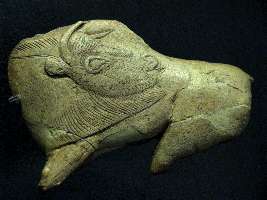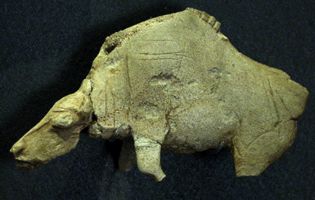Back to Don's Maps
Back to Tools of the Stone Age Index
Atlatls, Spear Throwers, and Woomeras
known as the Woomera in Australia
An atlatl or spear-thrower is a tool that uses leverage to achieve greater velocity in dart-throwing. It consists of a shaft with a cup or a spur at the end that supports and propels the butt of the dart. The atlatl is held in one hand, gripped near the end farthest from the cup. The dart is thrown by the action of the upper arm and wrist. The throwing arm together with the atlatl acts as a lever. The atlatl is a low-mass, fast-moving extension of the throwing arm, increasing the length of the lever. This extra length allows the thrower to impart force to the dart over a longer distance, thus imparting more energy and ultimately higher speeds. A traditional atlatl is a long-range weapon and can readily impart to a projectile speeds of over 150 km/h (93 mph).
Atlatl designs may include improvements such as thong loops to fit the fingers, the use of flexible shafts, stone balance weights, and thinner, highly flexible darts for added power and range. Darts resemble large arrows or thin spears and are typically from 120 cm to 270 cm (4' to 9') in length and 9 to 16 mm (3/8 inch to 5/8 inch) in diameter. Another important improvement to the atlatl's design was the introduction of a small weight (between 60 and 80 grams) strapped to its midsection. Some atlatlists maintain that stone weights add mass to the shaft of the device, causing resistance to acceleration when swung and resulting in a more forceful and accurate launch of the dart. Others claim that atlatl weights add only stability to a cast, resulting in greater accuracy.
Text above: Wikipedia
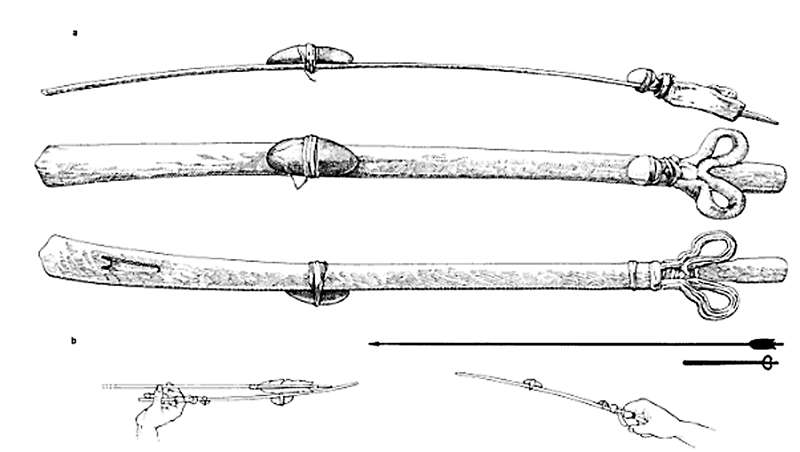
The Basketmaker II atlatl
a) Basketmaker II atlatl viewed from side, top, and bottom from Cist 1, Broken Roof Cave, Apache Co., Ariz.
Made of smoothly finished oak with a spur and groove (front view) to position dart. Finger loops made of 3-ply dressed skin and secured with sinew.
A small black nut, a light coloured moonstone, and dark red stone, possibly charms rather than for balance, have been fastened to the back of the shaft with sinew. The shaft is shorter and thinner than average and the present curved shape is due to warping. Length about 534 mm.
b) Method of use of atlatl for throwing dart and relative proportions of atlatl and dart.
Photo and text: Sturtevant (1978)
In 1921 a Harvard Peabody museum excavation team, led by Samuel James Guernsey made its way up the wash of the Chinle Creek in Northeastern Arizona. A twisting stream passing through flats and quicksand, the Chinle wash and it’s side-canyons stretch 65 miles from Apache county Arizona until it reaches the San Juan river in southern Utah. Along the flanks of this valley system can be found alcoves and caves, one of which, not far up a side canyon near the Utah border, came to be called 'Broken Roof Cave'.Text above: Justin Garnett, 2012, http://basketmakeratlatl.com/?page_id=491
Named for the frequent rock falls from the cave roof which threatened Guernsey’s team, Broken Roof Cave is a rockshelter 75 feet tall, 75 feet deep and 150 feet in length. The cave is situated atop a talus slope composed of rockslide debris which periodically ushers forth from the cave mouth. Following one such devastating rock fall and rockslide, the Peabody team decided to move on, as to continue excavations would be too dangerous to be worthwhile.
Diggings at Broken Roof Cave yielded many artifacts in exceptional states of preservation. The human burials dated to Basketmaker II, and were accompanied by typical grave goods - in cist 1, that of a ~40 year old male and four infants, were found three atlatl dart foreshafts with stone points in place, and the atlatl which is the subject of this article.
The atlatl was described by Guernsey in his site report as being the finest yet (in 1931) recovered by the Harvard Peabody Museum in their excavations. This is still true - the Broken Roof Cave atlatl is one of the finest preserved Basketmaker atlatls known. In the summer of 2010 I personally examined the weapon, and would feel confident in it’s ability to cast darts even today. The wood is oak (Likely Gambel oak, Quercus gambelii ) still hard, well polished and nearly unstained by time-even the hide of the finger loops is still pliable and soft to the touch.
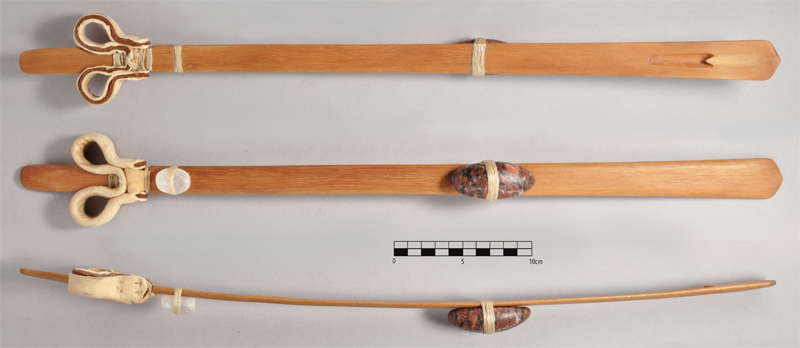
This superb replica of the Broken Roof Cave atlatl has both a small moonstone charm just above the loops, and larger, ground and polished weight attached above the mid-point of the shaft.
Replica by Devin Pettigrew
Photo: http://basketmakeratlatl.com/?page_id=418
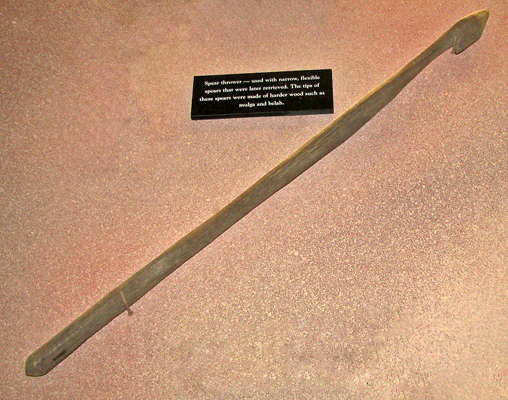
An Australian woomera. This one is unusual in that it serves no purpose except that of throwing a spear. Most woomeras were a swiss army knife, wide enough to carry things, to serve as a mixing bowl, or as an aid to fire lighting.
Some carried a flint blade on the end opposite the peg so that they could be used in wood shaping, cutting meat or for any other purpose. In addition, this example is made entirely of wood, without a marsupial tooth as a peg.
(Australian sources tend to refer to the hook of a spear thrower as a peg.)
Photo: Don Hitchcock 2009
Source: Display at Lake Mungo NP, southern NSW

Central Australian, western desert origin. Ovoid leaf shaped body. The front with incised decoration, the back adzed finished and has the original gum mounted peg. 85 cm
(note that this is an Australian woomera of the normal, broad type. Note also the knob on the right hand end to provide purchase, and the hook or spur on the left, possibly made from a kangaroo tooth - Don )
Photo and text: http://www.antiquesreporter.com.au/

An Aboriginal spear thrower, Woomera, Australia, of oblong shape, with both ends covered with resin, incised decoration of chevron on one side; aged brown patina, length 67 cm (26 1/4 in)
Condition: some resin missing, one chip on the side.
(note that the peg or spur or hook appears to be missing in this example - Don )
Photo and text: http://www.auctionatrium.com/

The back of this piece, undecorated.
(note the battered appearance of the back of the piece, as well as the shape of the wood underneath the partially resin covered handle - Don )
Photo: http://www.auctionatrium.com/

Carved woomera, 63 cm long.
(note that this is woomera is beautifully decorated with a zig-zag (snake?) pattern, and has a flint cutting tool on the handle end, making it a multi-purpose tool. - Don )
Photo: http://www.aasd.com.au/
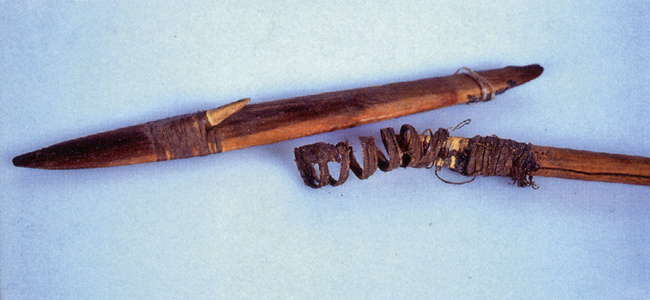
Australian spear, head section. The shaft was made from straightened canes of spearwood, (Pandorea doratoxylon ) while the head and barb were carved from mulga wood and tied on with kangaroo sinew. By using two different woods, Aboriginal toolmakers had the respective advantages of hardness and flexibility where it was needed in the weapon.
Photo and text: Clarke (2012)
Source: Western Desert Aboriginal Collection, South Australian Museum Archives
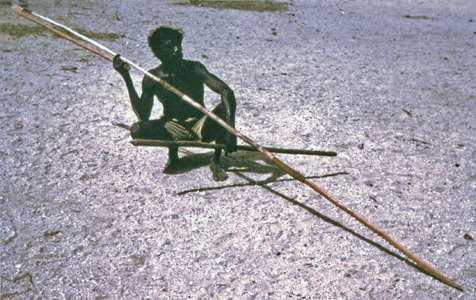
Lardil man demonstrating the grip of a spearthrower for launching 3-piece spears. Skilled use of spearthrowers gave greater force to thrown spears, while maintaining accuracy.
(Note the thickness, length, and resultant weight of this huge spear. It was presumably for large game such as Dugong. Dugongs are large grey mammals which spend their entire lives in the sea. Fully grown, they may be three metres long and weigh 400 kilograms - Don )
Photo and text: Clarke (2012), http://www.environment.gov.au/coasts/species/dugongs/index.html
Source: Norman B. Tindale, Bentinck Island, Gulf of Carpentaria, Queensland, 1966. AA346/6/241, Board for Anthropological Research, South Australian Museum Archives
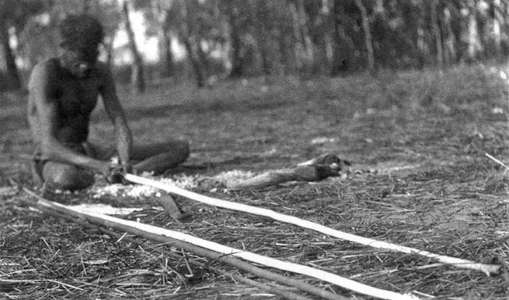
Wik Man shaping the base of a spear shaft. Before steel and glass were introduced into the region in historic times, this was performed using shell scrapers.
Photo and text: Clarke (2012)
Source: Ursula H. McConnel collection, Archer River, northwest Cape York Peninsula, Queensland, 1930s. AA191/23/2002, South Australian Museum Archives
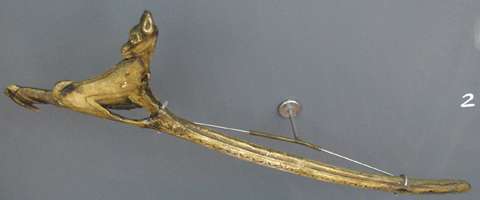
Propulseur 'au faon' (moulage) Le Mas d'Azil (Ariège), Magdalénien supérieur.
This atlatl or spearthrower or propulseur appears to have been carved from a single piece of antler.
It shows a young ibex or chamois with an emerging turd (or possibly a birth sac) on which two birds are perched, found around 1940 in the cave of Le Mas d'Azil, Ariege.
Photo: Don Hitchcock 2008
Source: Facsimile on display at Le Musée National de Préhistoire, Les Eyzies-de-Tayac

A North American atlatl and dart. Note the loops for thumb and finger on the atlatl.
Photo: Don Hitchcock 2012
Source: Display at Regina Museum, Saskatchewan, Canada
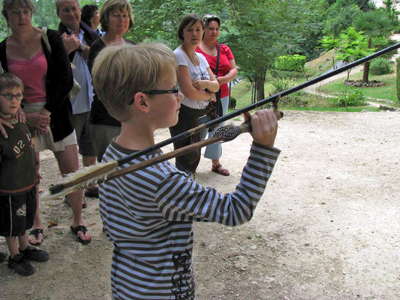
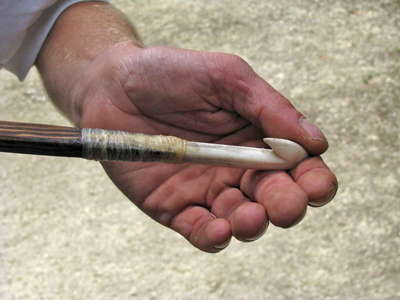
At Laugerie Basse in France you sign up for a tour, which is quite informative, though pretty much only in French. After the tour, the guide allowed all who wished a try with throwing a spear, or dart, using an atlatl, at a target he had set up.
The photograph on the right shows the hook or crochet or spur on the propulseur, made of bone or reindeer antler.
Photo: Don Hitchcock 2008
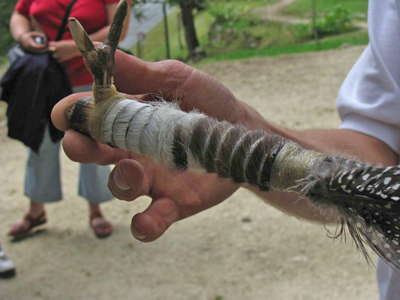
I don't know whether the original atlatls / propulseurs had this little stand for the dart, but it is a great invention. It makes the throwing of the dart easy, and requires very little skill to get a good result.
Photo: Don Hitchcock 2008
Carvings from La Madeleine in the Dordogne. These stunning pieces of art were used as decorations on propulseurs. A bison licking its shoulder on the left, a hyena in the centre, bison on the right.
Photo: Don Hitchcock 2008
Source: Originals (? the hyena looks like a facsimile) on display at Le Musée National de Préhistoire, Les Eyzies-de-Tayac
Another version of the hyena above:
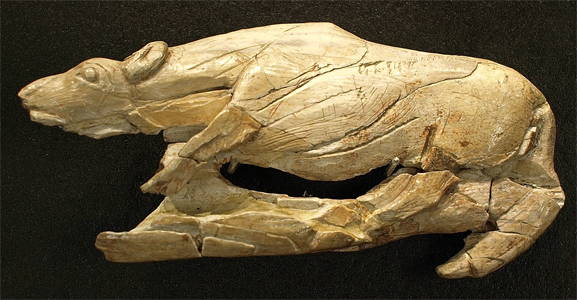
This is a large, high quality, in focus version of this very important work, and I am grateful to the uploader of the image. I have flipped it horizontally to agree with reality.
Wikipedia text: Part of a spear thrower made of reindeer antler, found in the Abri La Madeleine (Tursac in the Dordogne, France). Exhibit of the National Prehistoric Museum in Eyzies-de-Tayac.
Photo: Klaus D. Peter, Wiehl, Germany
Permission: Creative Commons License Attribution 3.0 Germany

This is an excellent recreation of what the propulseur with the hyena above as a part of the atlatl may have looked like, by Michael R. Frank.
Note that the craftsman has used the hyena as a decoration, with the hook below. This is the best and most believable recreation of these sorts of propulseurs or atlatls that I have seen.
Photo: http://www.occpaleo.com/atlatls/atlatldesigns.html
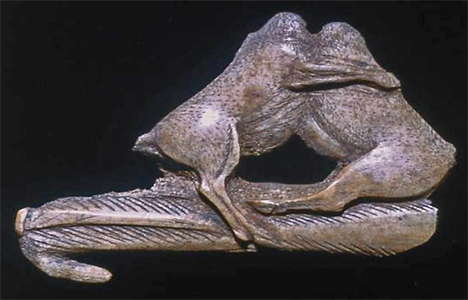
Les Trois-frères - two Ibex fighting, with the hook of the propulseur still attached.
Photo: http://www.studyblue.com/notes/note/n/arth-1450-exam-1/deck/2128191
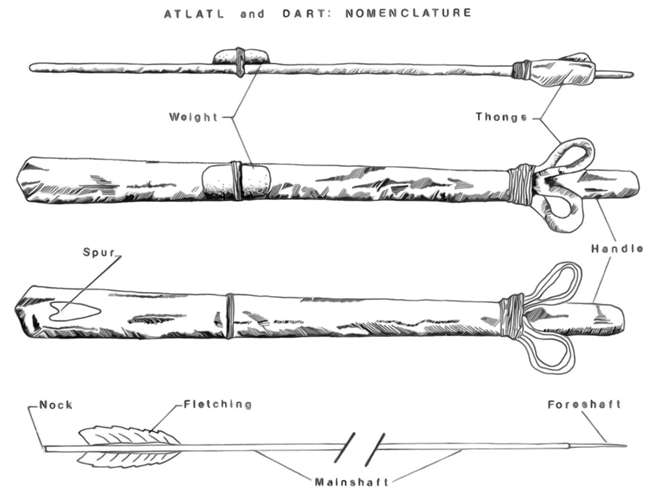
This is a typical North American atlatl. Note the slimness of the very hard wood used, the weight attached, and the loops for the thumb and finger, as well as the hook (rather than a socket) for the dart.
The dart is very thin and whippy, and is fletched, with a foreshaft which breaks away on impact, leaving the 'expensive' main shaft to drop away unharmed.
Photo: Raymond (1986)
The following is by far the best explanation of atlatl throwing that I have ever seen. Raymond (1986) has created a tour de force of explanation of many aspects of the atlatl and the dart, which I will summarise.
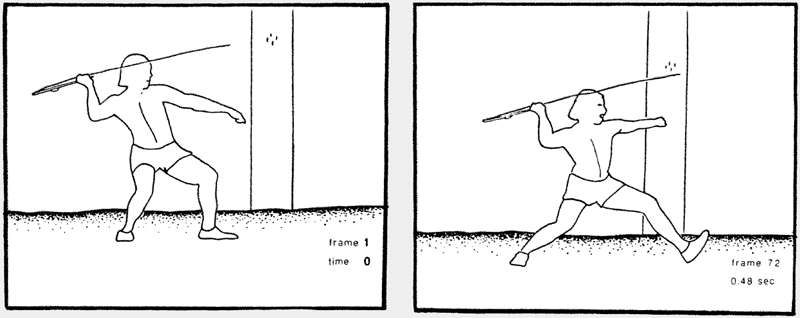
(Left) At time 0, the marksman takes aim with the atlatl by stretching his throwing arm behind his head. He arranges his shoulders parallel to the projected line of fire with his body weight on the rear leg. The fingers of the hand hold the atlatl grip and secure the dart to the atlatl spur.
(Right) At 0.48 seconds the marksman has rocked forward from the rear leg. He has stepped forward with his front leg towards the target and plants his heel. The upper body, shoulders, arms, and atlati have moved forward but have not changed their basic position from that in Figure 2.
Photo and text: Raymond (1986)
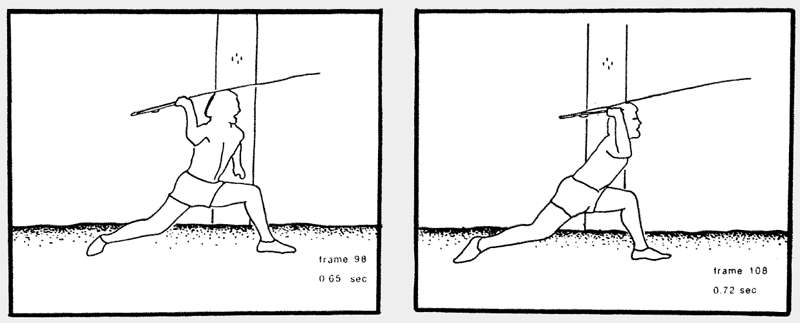
(Left) At 0.65 seconds, the marksman firmly plants his forward leading foot and leg. His upper body and shoulders begin to rotate around the spinal axis from a line parallel with the projected dart path to a line perpendicular to that path. The throwing arm is still bent at a 90 degree angle at the elbow.
(Right) At 0.72 seconds, his body weight has moved completely forward to the leading leg. His shoulders are perpendicular to the line of fire and his throwing arm is parallel with the shoulders but still bent to 90 degrees at elbow. At this point the fingers, which have held the dart flush with the atlatl, release their grip.
Photo and text: Raymond (1986)
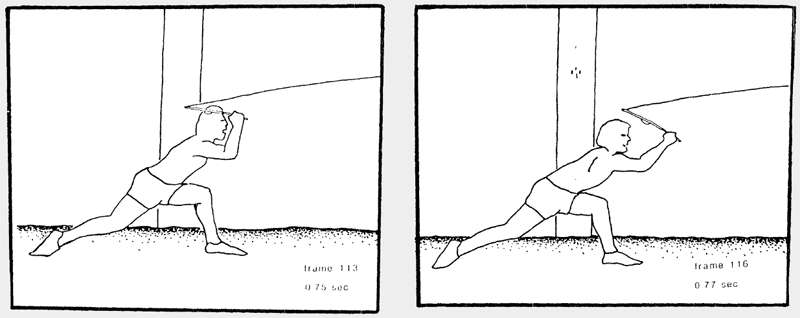
(Left) At 0.75 seconds, the elbow has reached its maximum forward extension in the line of fire. The forearm breaks the 90 degree angle at the elbow and begins to rotate downward.
(Right) At 0.77 seconds, the forearm continues its downward extension, while the wrist begins to rotate forward. The atlatl flexes under the stress.
Photo and text: Raymond (1986)
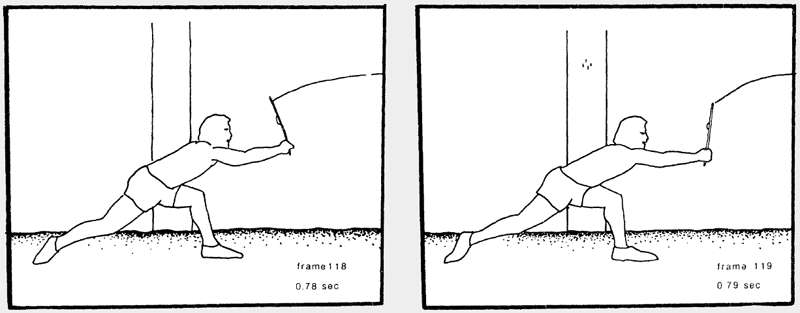
(Left) At 0.78 seconds, the forearm completes its extension as the wrist continues to rotate, pivoting the atlatl.
(Right) At 0.79 seconds the atlatl completes its revolution to form a 90 degree angle with the arm. The dart is released.
Photo and text: Raymond (1986)
However the following diagram is very instructive indeed, since it shows that the blunt end of the dart travels in almost a straight line, which is not something I would have realised, but would add to the power and accuracy of the throw when the technique is used by an experienced hunter.
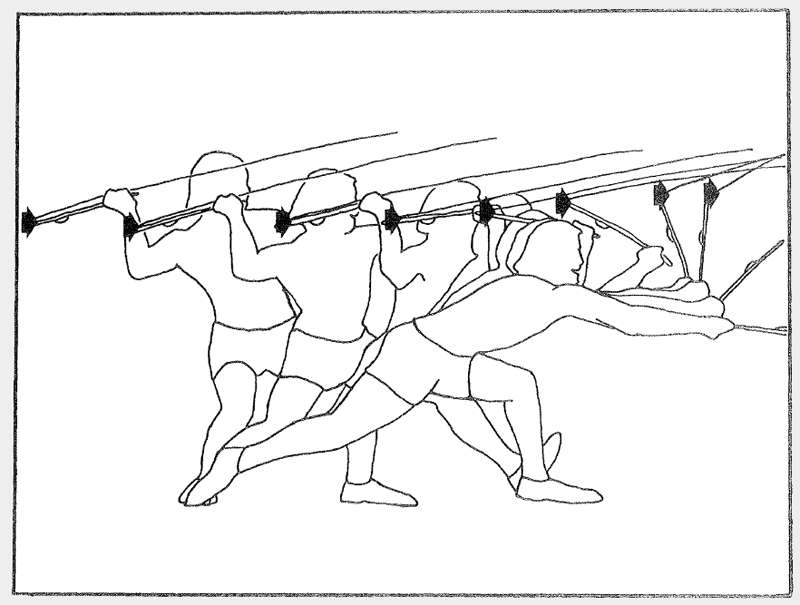
Superposition of all these diagrams shows that the point defined by the junction of the atlatl spur with the dart nock travels essentially in a straight line through space.
Photo and text: Raymond (1986)
This article makes the point that spears thrown by a woomera or spear thrower or atlatl need to be thin and flexible to work well.
From New Scientist 15 May 1999 pp 40-43
Stone Age Kalashnikov
It launches projectiles at high speeds, kills at 40 metres and can even be fitted with a silencer. Kurt Kleiner reveals the surprising sophistication of a 25 000 year old weapon.
William Robert Perkins notches the long, flexible spear onto a spur on the end of the stick in his hand. He draws back his arm, and throws. The spear flies away from the stick, an atlatl, towards the hay bales 30 metres away and thunks into the flattened cardboard beer carton that serves as a target.
Never mind that a few of the missiles miss the target and sail off into the Arizona desert beyond; everyone agrees that the atlatl can be tricky to use. Besides, Perkins, a former competition winner, has been so busy making and selling atlatls that he hasn't had much time lately to practise. The reason he's so busy is that the atlatl - a weapon that most hunters abandoned 10 000 years ago - is enjoying a renaissance. Thousands of people in America and Europe are making atlatls, competing in international tournaments, and even hunting with them.
Perkins, or Atlatl Bob as he's known, is no ordinary craftsman. Trained as an engineer, he is one of a group of people who have been studying the mechanics of this primitive weapon and found it to be surprisingly sophisticated. Using modern engineering concepts and experimental techniques, they are rediscovering ancient construction methods that make subtle but important improvements to the weapon's performance.
Armour piercing
'The physics and math is all in here,' Perkins says, weighing an atlatl in his hand at a recent workshop on primitive technology held near Phoenix, Arizona. 'It really impresses me, the ability of these ancient people to be able to do this. They certainly didn't have calculus. Wave mechanics, they didn't know that. But they knew intuitively.'
Atlatl is an Aztec word for what's also called a throwing board or spear thrower. But most enthusiasts object to the term 'spear', since it suggests a rigid shaft. An atlatl actually throws a flexible shaft that's more like a 150 centimetre long arrow and is properly called a dart. The atlatl itself is about 60 centimetres long, with a handle at one end and the small, sharp spur at the other. A dart thrown with an atlatl can kill a deer at 40 metres and will fly more than 200 metres. For comparison, the world record for throwing the, admittedly heavier, javelin is just under 100 metres.
According to archaeological evidence, the atlatl first made its appearance between 25 000 and 40 000 years ago in the region that today encompasses Algeria, Morocco and Tunisia. From here, it radiated outwards to Europe, Australia, Asia, and eventually the New World. Then, about 15 000 years ago, the bow and arrow began to displace the atlatl. The power and range of the two weapons are comparable but the bow and arrow is easier to aim. The atlatl's extravagant throwing action makes it more prone to wild shots, and can startle the prey. Still, in some places atlatls survived until more modern times. Aztec warriors greeted the invasion by Cortes in the 16th century with atlatl darts capable of penetrating Spanish armour, and Australian Aborigines still use them.
Today, many other people are rediscovering the atlatl, thanks largely to the trend for archaeologists to try to recreate the artifacts they find. Some modern enthusiasts also seem to stumble across the atlatl for themselves. 'People call up and say, 'I didn't know anyone knew about atlatls but me. I've been making these since I was eight years old',' says Leni Clubb, president of the World Atlatl Association, which is based in Ocotillo, California, and sponsors contests and demonstrations.
Perkins discovered the atlatl while studying engineering at Montana State University. He took a course in replicative archaeology and decided to make it the focus of his study.
Kickdown
One reason Perkins objects to the term 'spear thrower' is that it gets in the way of understanding how the atlatl really works. Some of the first archaeologists to experiment with atlatls tried to throw rigid spears, and managed only poorly aimed shots that flew just 45 metres. They concluded that only constant practice from childhood would have allowed any one to use the weapon effectively. In fact, a beginner can start to hit targets, large ones at least, after just an hour's practice.
So how does the atlatl work? The thrower holds the atlatl and dart parallel to one another and horizontal, with elbow bent and the hand just beside the ear. There's an initial forward motion with the shoulder, then the elbow straightens and finally the wrist flicks the atlatl forward with an action not unlike that of an overexuberant fly fisherman trying to lure a trout. The atlatl accelerates the rear of the dart through an arc, with a movement similar to that of an ancient ballista flinging boulders against the enemy.
That's the obvious part. What isn't so obvious is how the projectile springs away from the tip of the atlatl. In the early tests, the rigid spears were reluctant to part company with the atlatl. So, all too often, at the end of the throw, as the atlatl tip began to move downwards it would drag the back end of the spear down too, ruining accuracy - an effect called kickdown. (Some Inuit use atlatl like sticks to launch rigid harpoons. But these are launched downward from boats, and the kickdown effect doesn't make much difference.)
A flexible dart, by comparison, springs away from the atlatl tip. You can think of the dart as a spring, which is compressed by the initial force of the throw. The dart releases this stored energy at the end of the throw by pushing off the atlatl tip before the tip begins moving downwards.
Perkins also analyses the dart in terms of wave mechanics (see Diagram). At the start of the throw, the dart bends as the acceleration pushes against the mass of the stone tip. A wave propagates from the rear of the dart to its tip. When the wave reaches the tip, it is reflected back again.
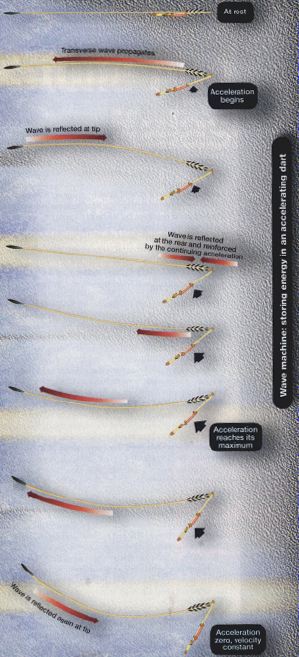
At the rear, the force generated by the still accelerating atlatl rein forces this wave and sends it once more towards the dart tip, where it reflects again.
When the wave reaches the rear this time, however, the atlatl has stopped accelerating, and the wave's energy strikes the atlatl tip and propels the dart forward. 'The wave goes through a cycle of harmonic oscillations, gaining a tremendous amount of energy as the dart's speed is increased,' Perkins explains. It's this energy, he argues, that makes most of the difference between the 45 metres that a rigid spear will travel and the 200 metre flight of a flexible dart.
But energy is not stored just in the dart. Atlatls also bend, and release their stored energy just as the dart launches. The atlatl's stored energy is more modest in size than that stored in the dart, and can probably account for increases in distance of about 10 per cent, reckons Perkins.
Looked at this way, the atlatl works very much like a bow and arrow. When an archer draws back the bowstring, the bow stores up energy which it releases very quickly to push the arrow forward. 'This is really the same weapon system as a bow and arrow,' says Perkins. 'It's a flexible shaft accelerator. The only difference is that a bow is a linear accelerator. It's accelerating a flexible shaft in a straight line. And the atlatl is doing it in an arc.'
For an ideal combination, the dart and atlatl have to be the right lengths, with the atlatl about one third as long as the dart. They also need to be made of the right stuff. Atlatls can be made from the same strong, springy wood that bows are made from, says Perkins. He uses an American hardwood called osage orange. Authentic darts he usually makes from red osier dogwood, but if you want a modern dart he supplies them in aluminium. The dart also has to be properly tuned. It must have the proper amount of flexibility for its mass, and needs a mass at the tip of the dart to aid compression. Perkins finds that a 7 gram stone point optimises his 100 gram wooden darts.
Perkins also thinks he has solved the mystery of atlatl weights - small, shaped stones which were often attached to North American atlatls. One suggestion was that they served a ritual purpose. But Perkins thinks the weights have a function. Mounted about halfway down the rear of the atlatl shaft, the weight helps to tune the flex of the atlatl. 'The atlatl weight improves the performance of the system in terms of efficiency,' he argues. 'Smoother, more controlled and powerful launches make for better accuracy.'
He also thinks a specific type of oddly shaped weight, called a banner stone, served as a kind of silencer, stopping a hunter's prey from being startled by the sound of the throw. Normally, an atlatl makes a distinctive 'zip' sound when the dart is thrown. But a banner stone, extending sideways like wings on an aeroplane, again about halfway down the atlatl, seems to muffle this sound. To test his theory, Perkins threw a number of darts over the head of a very brave engineer who measured the noise made by the launches. He found that, sure enough, atlatls with a banner stone made less noise than those without.
But could primitive atlatl makers really have taken advantage of all of these subtleties? Perkins believes they did. If the atlatl weights and banner stones aren't convincing enough evidence, there's also the mass of the stone points. For any dart, there is an optimum weight for the stone tip, and the tolerance is fairly narrow.
One day while at the Smithsonian Institution examining weapons left by native Americans from North and South Dakota, Perkins found three stone heads from the same site that had never been used. Two were made from chert, the third from much denser flint. All were made in the same way, but the one made of the denser stone was a centimetre shorter than the others. They weighed 7.6, 7.7 and 7.8 grams. If the maker had designed them by size alone, the denser point would have weighed much more. Perkins argues that this shows the maker had a standard weight which worked best with the darts.
Perkins hasn't proved his ideas, but archaeologists take them seriously. 'There's considerable difference of opinion among professional archaeologists. Folks like Bob are doing a real service by engaging in the actualistic research of these weapons,' says Leslie B. Davis, an archaeologist and curator at the Museum of the Rockies in Bozeman, Montana.
Others are more critical. Dick Baugh, another engineer turned atlatl maker, published a paper in Lithic Technology (Spring 1998) to counter the 'extravagant claims [that] have been made regarding the increased dart velocity achieved with a flexible atlatl'. Baugh created a computer model of a person using an atlatl, then changed the length and flexibility of the atlatl and removed the atlatl weights. He concludes that atlatl flexibility makes little difference to performance, and atlatl weights make even less. He also argues that while the dart's flexibility is important for launching it off the atlatl, it makes little impact on the distance the dart actually flies.
Ray Strischek of Athens, Ohio, who tied last year for best shot in the world, thinks the flex in the atlatl does make a difference. But rather than increasing velocity, he thinks it acts as a sort of shock absorber, buffering the jerkiness of the throw and creating a smoother, more accurate launch. 'The debate goes on,' says Strischek. 'No one has been able to quite pin it down.'
Until a machine with a perfect throwing action reveals the importance of all the various parameters, the experiments and controversy will continue as people continue to be fascinated by the atlatl. 'What separates us from other predators is our ability to throw a projectile at a prey,' says Perkins. 'No other animal on Earth can do that. This is just our supreme expression of using that natural ability.'
**N.B. Charlie Seljos writes to say: 'It is a common mis-conception that the ballista is identical to the catapult and onager -- ancient seige engines which used slings to hurl stones in an arc. However, Greek and Roman ballista did not actually do this. The ballista was more of a direct-fire weapon. They were the progenitors of the crossbow, having a set of moment-arms that pulled a stone along a trough to throw it.'
Further reading: Information about Atlatl Bob and his company can be found athttp://www.atlatl.com
References
- Clarke, P., 2012, Australian Plants as Aboriginal tools Rosenberg
- Raymond, A., 1986, Experiments in the Function and Performance of the Weighted Atlatl World Archaeology Vol. 18, No. 2, Weaponry and Warfare (Oct., 1986), pp. 153-177 Published by: Taylor & Francis, Ltd.
- Sturtevant, W., 1978, Handbook of North American Indians Volume 9: Southwest, Volumes 9-10, Government Printing Office, 1978 - 701 pages
